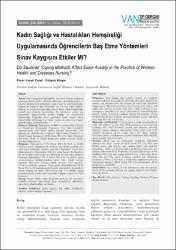| dc.contributor.author | Vural, Pınar Irmak | |
| dc.contributor.author | Körpe, Gülşah | |
| dc.date.accessioned | 2021-04-20T11:06:17Z | |
| dc.date.available | 2021-04-20T11:06:17Z | |
| dc.date.issued | 2020 | en_US |
| dc.identifier.citation | Vural, P. I. ve Körpe, G. (2020). Kadın sağlığı ve hastalıkları hemşireliği uygulamasında öğrencilerin baş etme yöntemleri sınav kaygısını etkiler mi? Van Tıp Dergisi, 27(2), 118-124. https://doi.org/10.5505/vtd.2020. 92653 | en_US |
| dc.identifier.issn | 1300-2694 | |
| dc.identifier.issn | 2587-0351 | |
| dc.identifier.uri | https://doi.org/10.5505/vtd.2020. 92653 | |
| dc.identifier.uri | https://hdl.handle.net/20.500.12511/6748 | |
| dc.description.abstract | Amaç: Sınav kaygısının öğrencilerin akademik başarısı üzerinde olumsuz etkileri vardır. Özellikle üniversite eğitiminde sosyal ve bireysel beklentilerin artmasıyla kaygı düzeyi de artabilmektedir. Öğrenciler kaygı ile baş edebilmek için bir baş etme yöntemi bulurlar ve hayatı boyunca diğer birçok kaygı verici konuyla baş etmede bu yönteme başvururlar. Bu çalışmanın amacı ise; hemşirelik öğrencilerinin Kadın Sağlığı ve Hastalıkları Hemşireliği Uygulama dersi uygulama sınavı öncesi kaygı düzeylerinin belirlenmesi ve sınav kaygısı ile nasıl baş etmeye çalıştıklarının belirlenmesidir. Gereç ve Yöntem: Tanımlayıcı türdeki bu çalışma Kadın Sağlığı ve Hastalıkları Hemşireliği Uygulama dersi alan hemşirelik öğrencilerinde 2017-2018 eğitim öğretim döneminde 139 öğrenci ile yürütülmüştür. Öğrenci bilgi formu, Durumluk ve Sürekli Kaygı Envanteri (STAI Form TX I-II), Beck Anksiyete Envanteri (BAI) ve Öznel Rahatsızlık Birimi (SUDS) ölçüm araçları kullanılmıştır. Bulgular: Öğrencilerin STAI Form TX I-II, BAI ve SUDS ölçekleri puan ortalamaları ile cinsiyet, yaş, ailenin yaşadığı yer, anne-baba birliktelik durumu arasında istatistiksel olarak fark bulunmamıştır. Öğrencilerin %44.6’sı sınav kaygısı ile baş etme de bir yöntem kullanmaktadır. Herhangi bir baş etme yöntemi kullanan öğrencilerin STAI Form TX I-II ve SUDS puan ortalamalarının kullanmayanlara göre daha düşük olduğu saptandı. Baş etme yöntemi olarak en çok nefes egzersizi (%14.4) yaptıkları saptandı. Ölçek puan ortalamalarında STAI Form TX I ve II arasında pozitif yönde orta şiddette istatistiksel olarak anlamlı bir ilişki, STAI Form TX I ve SUDS ölçeği arasında pozitif yönde zayıf istatistiksel olarak anlamlı bir ilişki bulundu. Sonuç: Sonuç olarak, sınav kaygısıyla herhangi bir baş etme yöntemi olmayan öğrencilerin kaygı düzeylerinin diğerlerine göre daha yüksek olduğu belirlendi. | en_US |
| dc.description.abstract | Objective: Test anxiety has negative effects on students' academic success. Especially in university education, the level of anxiety can increase with the increase of social and individual expectations. The students find a way to cope with anxiety and apply this method to deal with many other worrying issues throughout their life. The aim of this study is; determining the anxiety levels of nursing students before the practice of the Women Health and Diseases Nursing Practice course and how they cope with the test anxiety. Materials and Methods: This descriptive study was carried out with 139 students in the 2017-2018 academic year in nursing students who took Women’s Health and Diseases Nursing Practice course. Student information form, State and Trait Anxiety Inventory (STAI Form TX I-II), Beck Anxiety Inventory (BAI), and Subjective Units of Distress Scale (SUDS) measurement tools were used. Results: There was no statistically significant difference between the mean scores of STAI Form TX I-II, BAI and SUDS scales and gender, age, family place and parental association. 44.6% of students use a method to cope with test anxiety. The mean STAI Form TX I-II and SUDS scores of the students who used any coping method were lower than those who did not. The most common method was breathing exercises (14.4%). There was a statistically significant positive correlation between STAI Form TX I-II furthermore STAI Form TX I and SUDS. Conclusion: As a result, it was determined that the anxiety levels of the students without any coping methods were higher than the others. | en_US |
| dc.language.iso | tur | en_US |
| dc.publisher | Yüzüncü Yıl Üniversitesi Tıp Fakültesi | en_US |
| dc.rights | info:eu-repo/semantics/openAccess | en_US |
| dc.subject | Sınav Kaygısı | en_US |
| dc.subject | Baş Etme | en_US |
| dc.subject | Hemşirelik | en_US |
| dc.subject | Öğrenci | en_US |
| dc.subject | Kadın Sağlığı Uygulama | en_US |
| dc.subject | Test Anxiety | en_US |
| dc.subject | Coping | en_US |
| dc.subject | Nursing | en_US |
| dc.subject | Student | en_US |
| dc.subject | Women Health Practice | en_US |
| dc.title | Kadın sağlığı ve hastalıkları hemşireliği uygulamasında öğrencilerin baş etme yöntemleri sınav kaygısını etkiler mi? | en_US |
| dc.title.alternative | Do students' coping methods affect exam anxiety in the practice of women health and diseases nursing? | en_US |
| dc.type | article | en_US |
| dc.relation.ispartof | Van Tıp Dergisi | en_US |
| dc.department | İstanbul Medipol Üniversitesi, Sağlık Bilimleri Fakültesi, Hemşirelik Bölümü | en_US |
| dc.authorid | 0000-0002-8070-2840 | en_US |
| dc.authorid | 0000-0002-5192-7987 | en_US |
| dc.identifier.volume | 27 | en_US |
| dc.identifier.issue | 2 | en_US |
| dc.identifier.startpage | 118 | en_US |
| dc.identifier.endpage | 124 | en_US |
| dc.relation.publicationcategory | Makale - Ulusal Hakemli Dergi - Kurum Öğretim Elemanı | en_US |
| dc.identifier.doi | 10.5505/vtd.2020. 92653 | en_US |


















